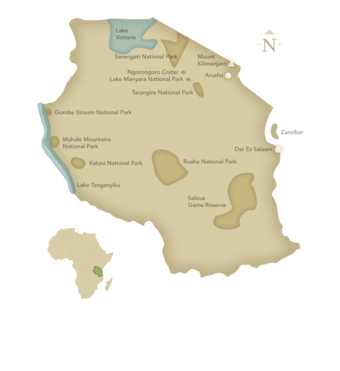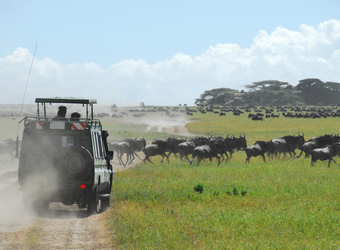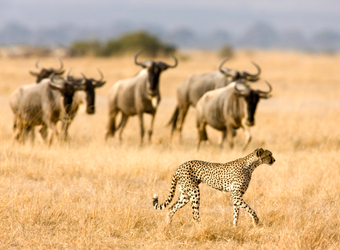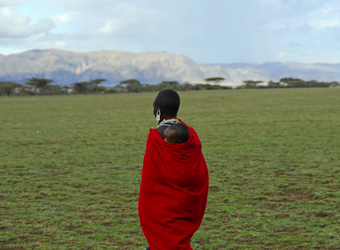Tanzania
| Read Reviews | Write a Review Start Planning Your Custom Safari
 view larger image
view larger image
Tanzania is iconic Africa. Where the snowclad summit of Mount Kilimanjaro surveys the plains of the Serengeti, wildlife abounds in staggering numbers. This is the site of one of the world’s most remarkable natural spectacles: the annual Great Migration when nearly two million wildebeest, zebra and gazelle traverse the savanna in pursuit of water and new grass. Predators like lion and cheetah stalk in their wake. Farther south, in Tarangire National Park, vast herds of elephant outnumber people. With some of the continent’s greatest concentrations of wild animals, Tanzania is duly famed as a top safari destination.
Read About the Different Regions and Parks in Tanzania

Our Expert Says
My journeys to Tanzania are the highlight of my Africa travels. I keep coming back because Tanzania offers amazing wildlife, great culture and some of the most stunning scenery on the continent. I love the feeling of standing on the edge of the Ngorongoro Crater, knowing I am about to experience one of the best wildlife experiences in the world as our vehicle drives down the winding road from the rim. Or when I look across the Serengeti Plains to see a herd of impala leaping over the low bushes, and in the same scene, I see a lone, tall Maasai warrior walking with his spear.
– Christy Lavoie
 view image gallery
view image gallery
Tanzania Safari Highlights
The Serengeti tops most Tanzania safari itineraries. A Masai word meaning “endless plains,” this protected ecosystem sprawls across 10,000 square miles. With a network of rivers ensuring year-round water, the region is incredibly rich in wildlife, though specific experiences, such as the Great Migration, vary with the seasons. Exceptional safari opportunities exist in the private reserves adjacent to Serengeti National Park, many of which are the exclusive domain of the camps we use. In addition to classic destinations like Ngorongoro Crater and Tarangire, famed for its elephants and baobabs, Tanzania offers vast, little-visited reserves such as Ruaha and Selous, true wilderness with striking scenery where you’ll encounter droves of animals but few other visitors. Mahale Mountains National Park on Lake Tanganyika is home to some of Africa’s last wild chimpanzees. For the perfect finale to your safari adventure, add a few days to relax on the beaches of Zanzibar.
 view image gallery
view image gallery
Tanzania Wildlife
Tanzania is famed for its wildebeest migration, the largest mass movement of land animals on the planet. The entire Serengeti ecosystem depends on the migration, with felines, hyena and birds of prey feasting on the young and weak while crocodiles lie in wait at each river crossing. Plains animals abound, including giraffe and gazelle. Ngorongoro Crater is often called a wildlife Eden. Zebra graze on its rim, while plenty of lion, flamingos and the endangered black rhinoceros are found within. Tarangire is famed for its enormous elephant herds. So is remote Selous, home to 3,000 lion, cheetah, hippo, black rhino and many of Africa’s last wild dogs, often sighted here and in Ruaha National Park. Vast Ruaha sustains buffalo, sable and roan antelope, elephants and rich birdlife. In the rainforests of Mahale and Gombe in western Tanzania, we find chimpanzees and colobus monkeys in their last wild habitat.
 view image gallery
view image gallery
Quick Tanzania Facts
Lying just south of the equator, Tanzania is East Africa's largest country, at 365,000 square miles. A poor though politically stable nation of 36.5 million people, Tanzania was formed in 1964 when Tanganyika and Zanzibar merged after achieving independence from Britain. The geography is diverse, ranging from volcanic peaks draped in tropical forest to dusty savanna where plains wildlife thrives. Tanzania is the most biodiverse country in Africa, with the continent’s biggest mammal population, second-largest number of bird species (around 1500) and 3/4 of East Africa's plant species. The best-known tribe is the Masai, a pastoral cattle-herding people in the north, yet there are 125 other distinct tribes in Tanzania. Tanzania’s economy is heavily dependent on agriculture, which provides half its GDP and employs 80 percent of the workforce, typically in subsistence farming or fishing. Tourism accounts for more than 1/6 of Tanzania’s income.
 view image gallery
view image gallery
Conservation in Tanzania
More than a quarter of Tanzania is protected—an outstanding conservation achievement. Tourism, much of which is nature-based, accounts for more than one sixth of the country’s income. Yet Tanzania’s parks and reserves are under pressure from poaching and illegal logging, lack of resources for effective management, and other conditions exacerbated by a growing population struggling with poverty. Progress continues, however, advanced by education, understanding of local economies, and sustainable development. WWF is working with government, local communities and the private sector to protect Udzungwa Mountain National Park, which supports some of the most ancient and diverse biological communities in Africa. More than a third of the park’s plant and animal species are endemic, rare and endangered. WWF is also working to improve management of the Mara River, a critical water supply in the Mara-Serengeti ecosystem.
